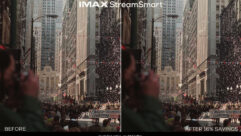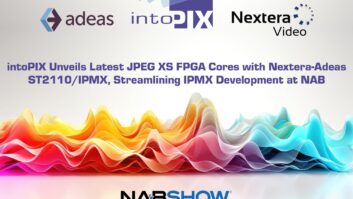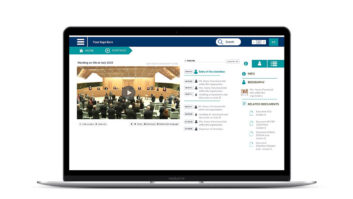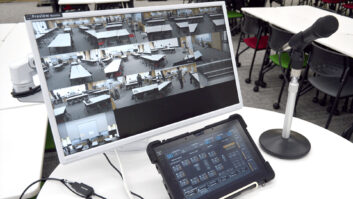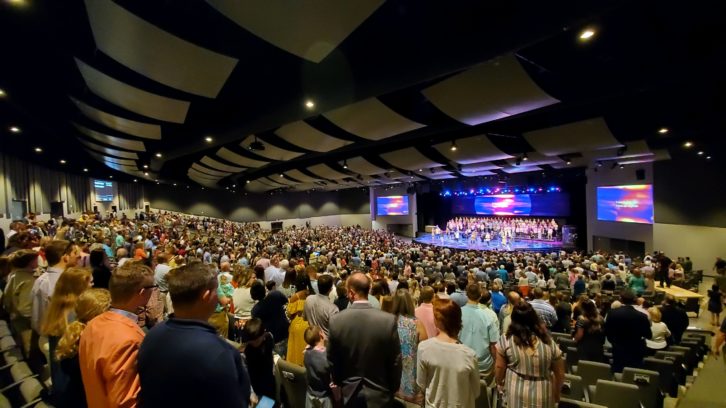
For centuries, those who practice worship have sought immersive and inspiring communication and experiences, conjuring three-dimensional sound and compelling images in a range of creative and often pioneering ways. Worship communities have always used grand and intimate expressions of art, architecture, music, imagery, and symbolism to come together. Now, as AV technology becomes more immersive and interactive, there’s a natural fit with media ministries, which can use them to create new rituals and connections for their communities. In some cases, these technologies represent the cutting edge of AV. –Cynthia Wisehart
Immersive Soundscapes
Immersive electro-acoustics and other immersive sound technologies are still considered new in environments such as museums, theme parks, retail, and restaurants. Now d&b’s implementation Soundscape has found application in a house of worship, where the ability to reshape the physical perception of the audio space preserved a sense of intimacy for the community as it moved to a very large space.
This was an important transition for a church that started out in 1988 in the living room of founding Pastors Floyd Loudermilk and his wife Sara. Now the Anderson Mill Road Baptist Church (known locally as the Church at The Mill), located just outside of Spartanburg, South Carolina, has recently outgrown its 800-seat home worship center and moved into a new, state-of-the-art multi-venue facility. This facility incorporates a 2,200-seat main auditorium along with other environments to engage all members of the congregation — and especially young people.
To serve their growing vision, church leadership wanted to create an audio environment that could accommodate the spoken word, full contemporary band performances, and a 150-voice choir, without losing the personal connection between communication and source that defined the church.
Church leaders contacted their longtime partner sound system integrator XL Mediaworks Inc. in Columbia, South Carolina for their help. XL Mediaworks originally proposed a V-Series system with a trio of Allen & Heath dLive digital audio consoles as part of the new audio, visual and lighting system. With the recent release of the d&b Soundscape system, Jerry Temple and David Seaford from XL Mediaworks invited The Mill`s Executive Pastor, Ken Fisher, to attend a Soundscape demonstration at a nearby church.
Pastor Fisher immediately recognized what Soundscape could bring to the worship experience for shaping the audio experience and preserving the church’s intimate vibe, while moving up to a building that would nearly triple their seating.
The main auditorium design presented acoustical challenges that are common to contemporary worship spaces: an overall fan-shaped space, with a sloped lower bowl and raked seating in the upper sections.
“The room is very wide with relatively low ceilings,” explained Seaford. “This posed some challenges in obtaining good audio coverage without compromising sight lines to the main video screen and two side video screens. Long line arrays would block the screen view for many audience members. A distributed system would be the next choice, but with this approach, the audience tends to localize sound to the nearest speaker, not to the presenter or performer — this is where the d&b Soundscape system could solve the problems.”
Using a combination of speaker placement and source-position information, the d&b En-Scene software algorithm utilizes the processing power of the DS100 signal engine to sonically reinforce the image of what is on stage by harmoniously localizing individual sources precisely as they are seen. This pivotal change in system design and mix approach allows every voice, instrument or sound source to be represented true to its original form.
“We could not be more pleased with the final result,” stated Pastor Fisher. “The d&b Soundscape solution clearly has the ability to create an intimate setting even in a sanctuary of over 2,200 seats. Our desire is to ensure that all distractions are removed during our time of worship — the quality of sound delivered by Soundscape not only removes audio distractions, but actually enhances the personal worship experience.”
From a system point of view, Soundscape means that loudspeaker positions cooperate with each other, using source-relative time and level information to create a completely coherent wave front emanating from the original source.
The XL Mediaworks team explained it best this way: Imagine introducing the principles of time, width, depth and texture as you would find in the subtle nuances of a jazz trio playing acoustically in an intimate venue, and then overlay that experience onto a worship audience. Soundscape delivers a more transparent experience for contemporary or traditional worship, but perhaps most importantly, the spoken word is delivered full of feeling and passion, making the loudspeakers sonically disappear.
From the front row to the furthest seat in the auditorium, some 120 feet away, Soundscape delivers a consistent level of tonal quality, SPL, and a true imaging perspective for every seat in the house. The system’s added efficiency through Soundscape and ArrayProcessing allows for concert-level music reproduction and localization for every source to every seat and respect for sight lines with only six boxes per Y-Series hang for the mains, and zero delays. The engineer is able to fine-tune an impactful mix on the Allen & Heath dLive digital mixing console at FOH while reducing overall SPL levels and thus listening fatigue from members of the congregation.
“The Church at the Mill has accomplished their goal of delivering an emotionally-resonant worship experience,” added Asher Dowson, House of Worship Segment Manager, d&b audiotechnik. “It’s a full sonic production for more than 2,200 congregants — but each person in attendance feels as though it’s all just for them.”
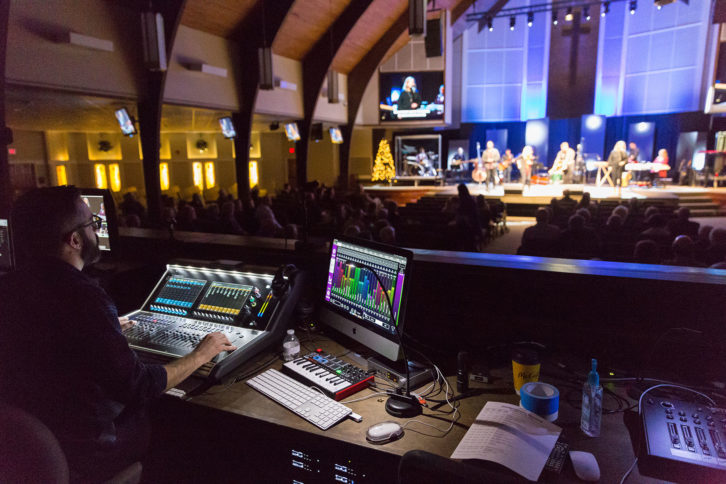 In-ear Immersion
In-ear Immersion
It’s not just the congregation that benefits from immersion. As touring musicians and Broadway performers understand, immersive monitoring can supercharge a performance. That in turn translates to the audience— the congregation. This connection can matter, even on a small scale.
Leaders at Willowbrook Baptist Church’s main campus in Huntsville, Alabama recently completed the first step of a multi-phased initiative to update the worship center. A key part of that process was the implementation of a KLANG:fabrik immersive in-ear monitor mixing system for its 12-piece worship orchestra.
Installed by Byhalia, Mississippi-based integrator Redwire Audio Visual in October, the new KLANG system offers up to 16 musicians their own unique IEM mixes over RF transmitters, or headphone amps via XLR. The supporting KLANG:fabrik is a flexible audio network router of up to 64 MADI, 64 Dante and 32 ADAT-compatible inputs and outputs.
“Their worship orchestra had been frustrated by the lack of flexibility with their old IEM system,” says Redwire AV President, Founder and General Manager Tim Johnson. “So we brought the KLANG:fabrik in for a demo, and they experienced a huge difference immediately.”
Johnson says the KLANG:fabrik’s ability to operate at 96kHz offers a much higher level of sonic fidelity to the musicians. Furthermore, the ability to move mixes around in a fully immersive space has changed how they hear themselves and the music.
“They literally had no idea this science was possible,” says Redwire AV Lead Designer Charles Thompson. “They can put the click above their heads, for instance, and build a virtual stage that reflects where each of them are standing on the actual stage. This creates a realistic in-ear environment that helps them hear everything accurately, because they can hear each other where they are physically, not just left and right.”
Johnson adds that this kind of immersive monitoring environment on stage also helps keep volumes down, which is good for both the music and the congregation in the 800-seat sanctuary. “It also really cleans up the stage visually,” he says. “Everyone is already using an iPad for charts, so the KLANG just plugs into that same device, keeping things very uncluttered.”
The KLANG:fabrik takes feeds—via Dante and three DiGiCo A168 STAGE I/O Expanders—from a new DiGiCo S21 console. “It’s even made the existing sound system perform better, with excellent clocking that dealt with digital ‘smearing’ issues they had with the previous console that muddied the sound,” Johnson says.
The orchestra and church liked the system so much that a second Klang:fabrik unit has already been ordered, to be installed in the next AV upgrade phase, which Olson says will provide the musicians with even more channels with which to build their custom mixes on stage.
Willowbrook Minister of Production Chris Olson echoes that the church’s musicians were impressed immediately by the KLANG:fabrik’s sound and ease of use. “They’re able to put their instruments exactly where they want in the sound field and spread the entire image out nicely, which really makes them more comfortable on stage,” he says. “Plus, it does help keep the stage looking neat and clean, so it’s all just ‘plug and play’ for our tech team, with everything on just a single Cat-5 cable, and by eliminating all of the individual mixers on stage.”
In a similar vein, For the worship team at Woodbury Lutheran Church in Minnesota’s Twin Cities, the switch to KLANG:fabrik in-ear monitors came after 25 years with stage monitors.
Moving to an immersive IEM system for monitoring was a big change. Add to that the fact that the install took place only a week and a half before one of Woodbury’s biggest productions of the year, Easter weekend, leaving little time to train and acclimate musicians and technical staff.
Technical Arts Director Kendall Johnson, who has headed the production ministry at Valley Creek since 2016, acknowledges the timing challenge. “We installed KLANG on April 10th, during the busiest time of year for our church,” he recalls. “We had a huge Good Friday production about 10 days after the install date and needed to get our volunteers trained on and comfortable with the new system.”
With a degree in sound design for interactive media and having interned at Hans Zimmer’s studio, Remote Control Productions, Johnson has little fear of cutting-edge tech, but the same can’t necessarily be said for Woodbury’s musicians, many of who have been using the church’s existing wedge system since 1992. Thankfully, he says, the transition was painless: “People could not believe how well they could hear. They went from thinking that the immersive audio idea was a gimmick to being fully on board within just a few songs.”
For churches like Woodbury, the combination of precise placement of sound sources within a highly immersive soundstage and the fact that individual musicians can customize their own mix via a mobile device of their choice has been convincing.
“Moving from wedges to an in-ear-monitor system is all about setting up our teams to lead worship with confidence,” notes multi-site Worship Director Joel Wetzstein.
“Funny story: during sound check for Easter Sunday, I was seriously startled by the KLANG system,” Wetzstein laughs. “I was sitting at the piano and hadn’t finished placing every instrument in my immersive sound field when the percussion player hit one of his drums. I whipped my head to the left to see who was there because even though I knew the percussionist was on the other side of the stage, it sounded like he was standing right there! I couldn’t believe how good and accurate the placement sounded. Truth be told, that happened more than once.”
Johnson routinely has to deal with three major services in a four-day period, all of which have completely unique channel assignments. “Each week, we have multiple worship teams using the system—different musicians, different names, different setups. It’s incredibly easy to save and load all of these setups.”
The 2U rack device accepts up to 56 input channels via a variety of digital formats—including MADI, Dante and Lightpipe—giving the flexibility to easily route audio in and out the device. XLR audio outs can be used to distribute the audio out of the console as well as any of the digital formats. If there is a need for additional mixes, multiple KLANG units can be daisy-chained. KLANG’s immersive in-ear mixing system can be controlled via KLANG:app, which is compatible with iOS, Android Mac and Windows devices. For owners of DiGiCo’s SD series, there’s also a native implementation of the control surface on the desk.
“KLANG has revolutionized how we’re able to rehearse and lead worship,” says Karl Grant, one of Woodbury’s worship leaders. “Each member of the band can hear exactly what they need to hear—and no more than that. They get to choose! We save time in rehearsals by not having to call back monitor mix adjustments, and, as a worship leader, I have much more confidence in my own monitoring of what the ensemble sound is. KLANG is also helping us all realize where we need to tighten up as musicians.”
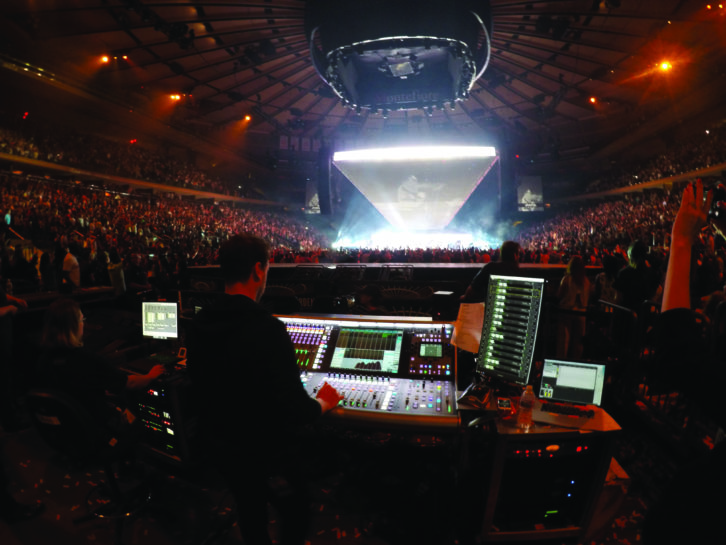
Tour Configuration
It’s one thing to replicate an engaging atmosphere and integrated workflow in a fixed location. But what if you need to replicate that time after time in many locations? One tool that can make a difference is predictive modeling software for speaker tuning.
With an estimated 50-million-plus people singing from its catalog of songs every Sunday and over 1.5 billion minutes garnered from YouTube viewers, Australia’s Hillsong Church is unquestionably one of the primary architects of modern worship music.
Although the Sydney-based organization has several performing collectives that tour worldwide, Hillsong UNITED is likely the best known. According to Billboard, the group’s 14th and most recent album, People, made its late-April debut last year as the week’s top-selling album across all US charts—not just Contemporary Christian—underscoring the band’s enormous popularity.
When Hillsong UNITED headed out to support People with its first North American trek in three years, Hillsong called upon Solotech’s Nashville shop to carry an L’Acoustics’ K1/K2 rig for the run; L’Acoustics’ modeling software Soundvision ended up playing an important supporting role.
Systems Engineer Arica Rust notes that the tour’s base arena configuration consisted of 12 K1 with four K2 down on the main left and right hangs, four K1 on top of eight K2 for the side hangs, and six K1 with six Kara down for the 270° arrays. The crew also deployed two dozen SB28 subs on the ground in a symmetrical cardioid configuration in three clusters of four on either side of the downstage thrust, spaced four feet apart.
Sixteen Kiva II delivered frontfill. Depending on the venue, these were usually stacked three high on the middle sub cluster for the “inside” fill, and then either two or three stacked on the outside sub cluster. Because there was VIP standing room on the side of the stage, the last two or three Kiva II were used as an upstage outfill to cover that area and provide additional coverage to the first couple of rows of seats under the 270° hang.
For the largest shows, such as Toronto’s Scotiabank Arena and New York’s Madison Square Garden, Solotech deployed an additional two K1 on each main hang for a total of 18 enclosures, and swapped out the side hangs for all K2. Forty-eight LA8 amplified controllers drove the entire PA via AES over RIEDEL RockNet.
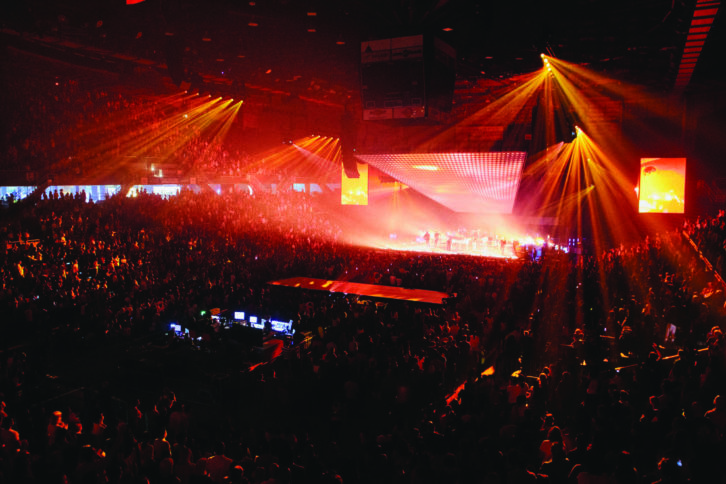 As an example of the variety they encounter on the road, Rust says there were several elements that were rather unique to this show. “In addition to the main stage, we had a ‘B stage’ where the opener, Mack Brock, and some of UNITED’s more intimate, acoustic songs were performed,” she notes. “This stage was located in front of the PA on the arena floor, sometimes very close to front of house. With the valuable assistance of our PA techs, Nick Stover and Mike Bradley, I tried my best to not aim boxes directly at the stage, but was actually pleasantly surprised by how much gain before feedback the PA exhibited even with these elements.”
As an example of the variety they encounter on the road, Rust says there were several elements that were rather unique to this show. “In addition to the main stage, we had a ‘B stage’ where the opener, Mack Brock, and some of UNITED’s more intimate, acoustic songs were performed,” she notes. “This stage was located in front of the PA on the arena floor, sometimes very close to front of house. With the valuable assistance of our PA techs, Nick Stover and Mike Bradley, I tried my best to not aim boxes directly at the stage, but was actually pleasantly surprised by how much gain before feedback the PA exhibited even with these elements.”
The tour’s sub configuration was also unique in that they had to separate the subs left and right due to the downstage center thrust dividing the array. “We wanted to steer the low-frequency energy away from it, so having a symmetrical cardioid configuration with the reversed sub onstage slightly steered the polar response of the subs away from the thrust,” Rust shares. “In addition, we delayed each cluster slightly using values based off Soundvision predictions to create a slight arc to spread the low-frequency coverage better throughout the floor. The great thing about K1 is that even though we did not have flown subs, the full range of the box goes down to 35Hz so it can deliver LF content to the back of an arena especially when used in conjunction with the LF Contour function in Array Morphing.”
She goes on to add that another challenge they had to work with was the roof structure and video wall that displayed the lyrics. “It was crucial that the PA did not end up being shadowed by the corners of the structure, but fortunately all this can be drawn in, and thus results predicted and adjustments analyzed, in the Soundvision model,” she notes.
Rust explains that every venue had to be modeled in Soundvision because every Soundvision file translated directly into an import into Network Manager that reflected the variables of that day’s configuration. “On a typical day, I would go into the venue first thing in the morning, take measurements, compare them to the Soundvision database model if there was one, and build a XMLP file,” she recalls. “It was imperative that the vertical measurements were accurate to dictate correct placement of dmin, dref, and dmax for the Autosplay functions to predict properly
“The Autosplay and AutoFIR tools were an inherent part of my workflow because Auto Init and Optimize would help me optimize the inter-element angles quickly where I could then make minor adjustments as necessary for each day’s deployment. I relied heavily on the AutoFIR to create an even starting point in coverage and integrity in the PA. I would try to use the same loudspeaker configuration data file in Soundvision every day so that I could use the same Network Manager file and load new synchronization groups with updated FIR filters, which saved a ton of time rather than daily trying to rebuild customizations.”
One exception to this workflow was when she had to change the configuration of the PA. The tour consisted of a wide variety of venues and some arenas were smaller than others or had trim height restrictions so then the PA configuration itself had to be altered to fit the requirements of that venue. “Being able to quickly assess the effects of these variables in a model in Soundvision helped me make quick decisions on how to manipulate the deployment for that day.
“Hillsong UNITED have a very dynamic set. The show goes from bass-driven dance content to soft, spoken-word or acoustic pieces. Even tonality throughout the entire audience area is mission-critical for this application as much as SPL. I could walk around with James [Rudder, FOH Engineer] and the trusty VNC tablet listening to the entire system as a whole and each of the subsystems scaled evenly to create a consistent coverage across the listening plane.”


